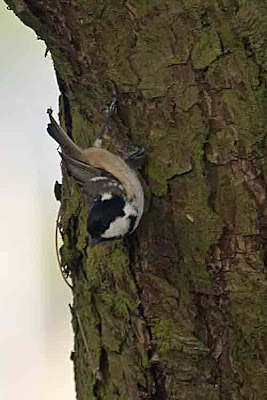Once the fog had lifted (it stayed hazy all day at St Margaret's) I decided on a walk along the cliff top, hoping that the weather had grounded some interesting migrants. The first two birds that I saw were two Ring Ouzels, disappearing into some thick scrub on the cliff top just down from the "Bluebird" cafe.
Several Goldcrests were calling in the group pines on the way to Hope Point. They were constantly on the move but there was no sign of the hoped for Firecrest.
I imagine that many of the Goldcrests in bushes on the cliff top are recent arrivals. These tiny birds need to feed up rapidly to gain the fat that is the fuel of their own heating overnight. The temperatures this week are forecast to remain quite high, but by the end of the week we will be getting a cold air stream from the north. When this happens it is critical that the small birds can feed to maintain a sustainable weight (they get up to nearly 6 grams when really fat and can fall to about 5 grams, that's 6 to the ounce).
Near by there were five Stonechats, moving from the top of one bush or tree to the next. They really are obliging, and easy to see.
Another set of bushes to look through, and more Goldcrests and a couple more calling Ring Ouzels diving into deeper cover.
The bubbling call of a Curlew on the rocks about 250 feet below had me peering over to see it I could find it. They are surprisingly difficult to see in the mixed pattern of chalk pavement and seaweed.
Looking back from Hope Point to the Monument the mist still hadn't relented, and although the sun managed to appear for spells by mid afternoon it was beginning to thicken up.
I one of the gardens on Kingsdown Less a group of Long-tailed Tits noisily move through in a feeding flock. With the group were more Goldcrest and a couple of Coal Tits. Another two or three Ring Ouzels were loudly clacking in the trees and two Mistle Thrushes added their quicker rattle to the background noise. One small hawthorn bush held four Blackbirds and five Song Thrushes, but whether these were part of a arrival I can't be sure.
The roofs along here are always worth a quick look as they seem to regularly attract Black Redstarts. this one quickly disappeared over the top of the apex and I failed to re-find it.
On the way back to the Monument a movement in a small hawthorn bush caught my eye and I fully expected another Goldcrest. This time though I was lucky and a stunning Firecrest popped up for a couple of seconds.
I've always thought that the Firecrest is probably the most stunning British bird.
They are pretty much the same size as Goldcrests but appear slightly bulkier and more bull headed, but this might be due to the more striking head pattern.
As the evening arrived the light faded quickly and I left the bird still in the same bush right by the cliff top.One other thing that I noticed during the cliff top walk was the very large number of small moths kicked up from the grass. On close inspection they were Rush Veneers, a migrant that can arrive in very large numbers.













No comments:
Post a Comment